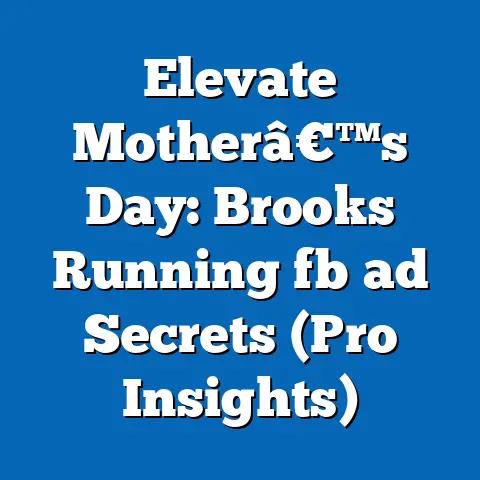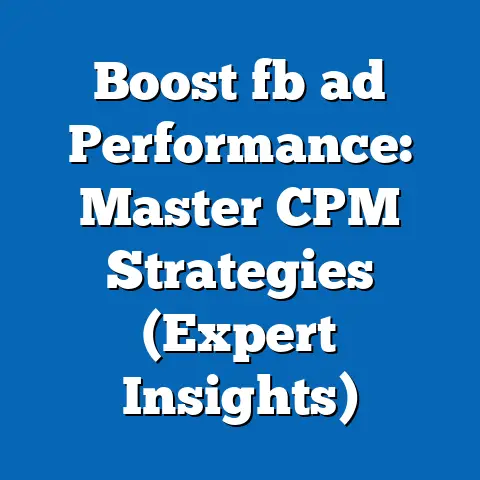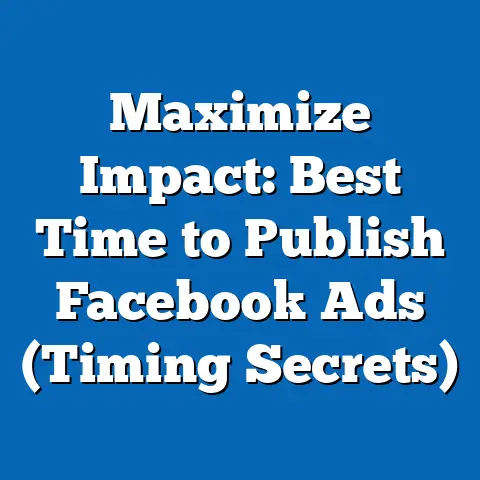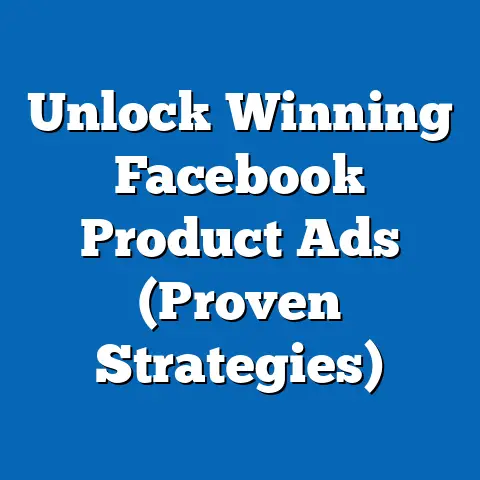Unlocking Best Facebook Lead Ads 2025 (Proven Strategies)
In today’s digital age, where inclusivity and accessibility are not just buzzwords but fundamental aspects of responsible marketing, Facebook Lead Ads stand out as a powerful tool. I’ve seen firsthand how businesses can leverage these ads to generate high-quality leads while ensuring their message reaches a broader, more diverse audience. Accessibility in Facebook Lead Ads is no longer optional; it’s essential for tapping into the full potential of the platform and building a brand that resonates with everyone.
Think about it: excluding individuals with disabilities isn’t just ethically questionable; it’s bad business. By making your ads accessible, you open the door to a significant demographic that might have been previously overlooked. This means more engagement, higher conversion rates, and a more positive brand image.
In this article, I’ll walk you through proven strategies for optimizing your Facebook Lead Ads in 2025, with a laser focus on accessibility and inclusivity. We’ll explore design best practices, inclusive messaging techniques, and the latest accessibility tools Facebook offers. Get ready to transform your lead generation efforts and make a real difference in the digital landscape.
Section 1: Understanding Facebook Lead Ads
What are Facebook Lead Ads?
Facebook Lead Ads are a type of advertisement specifically designed to collect information from potential customers directly within the Facebook platform. Unlike traditional ads that redirect users to an external landing page, Lead Ads allow users to fill out a form without ever leaving Facebook or Instagram. This streamlined process significantly reduces friction and can lead to higher conversion rates.
From a user’s perspective, the experience is simple and intuitive. They see an ad that piques their interest, click on a call-to-action button (like “Sign Up” or “Get a Quote”), and are presented with a pre-populated form. Facebook automatically fills in the form with information the user has already provided on the platform, such as their name, email address, and phone number. The user can then review and submit the form with just a few taps.
I remember one campaign I ran for a local gym. We used a Lead Ad to offer a free trial. The simplicity of the process – no external website, no lengthy forms to fill out – resulted in a 30% increase in leads compared to our previous campaigns that directed users to the gym’s website.
Relevance in the Digital Marketing Landscape
Facebook Lead Ads are incredibly relevant in today’s digital marketing landscape for several reasons:
- Mobile-First Optimization: They are designed with mobile users in mind, which is crucial considering the majority of Facebook users access the platform via their mobile devices.
- Seamless User Experience: By keeping users within the Facebook ecosystem, they reduce the likelihood of drop-offs and abandonment.
- Targeted Lead Generation: Facebook’s robust targeting options allow you to reach specific demographics and interests, ensuring that your ads are seen by the most relevant audience.
- Data-Driven Insights: Facebook provides detailed analytics on the performance of your Lead Ads, allowing you to track key metrics and optimize your campaigns for better results.
According to recent statistics, Lead Ads have been shown to generate leads at a cost-per-lead (CPL) that is significantly lower than traditional methods. For example, a 2024 study by HubSpot found that businesses using Lead Ads saw a 20% reduction in CPL compared to those using standard website landing pages. This makes Lead Ads a cost-effective solution for businesses of all sizes.
Accessibility in Digital Advertising
Accessibility in digital advertising refers to the practice of designing and developing online advertisements in a way that ensures they are usable by people with disabilities. This includes individuals with visual, auditory, cognitive, and motor impairments. Accessibility is not just a matter of compliance with regulations like the Americans with Disabilities Act (ADA); it’s about creating a more inclusive and equitable digital experience for everyone.
Ignoring accessibility can have significant consequences. Not only do you risk alienating a substantial portion of your potential audience, but you also miss out on the opportunity to build a more positive and inclusive brand image.
Common Accessibility Issues in Facebook Ads
Many common issues can hinder the accessibility of Facebook Ads:
- Poor Color Contrast: Insufficient contrast between text and background can make it difficult for users with low vision to read the ad.
- Small Font Sizes: Small or overly stylized fonts can be challenging for users with visual impairments.
- Lack of Alt Text: Images without descriptive alt text are inaccessible to users who rely on screen readers.
- No Captions or Transcripts: Videos without captions or transcripts are inaccessible to users who are deaf or hard of hearing.
- Complex Language: Jargon, technical terms, and overly complex sentences can be confusing for users with cognitive impairments.
- Lack of Keyboard Navigation: Ads that cannot be navigated using a keyboard are inaccessible to users with motor impairments.
These issues can significantly impact engagement and lead generation. For example, a user with low vision may struggle to read the text on your ad, leading them to scroll past it without engaging. Similarly, a user who is deaf may be unable to understand the message in your video ad if it lacks captions.
Takeaway: Understanding the fundamentals of Facebook Lead Ads and the importance of accessibility is the first step toward creating effective and inclusive campaigns. By addressing common accessibility issues, you can ensure that your ads reach a wider audience and generate more leads.
Section 2: Proven Strategies for Creating Accessible Facebook Lead Ads
Creating accessible Facebook Lead Ads requires a thoughtful approach to design, messaging, and the use of Facebook’s built-in accessibility tools. Here are some proven strategies to help you create ads that are inclusive and effective.
2.1 Design for Accessibility
Visual design plays a crucial role in the accessibility of your Facebook Lead Ads. Here are some best practices to follow:
- Color Contrast: Ensure that there is sufficient contrast between text and background. Use tools like the WebAIM Color Contrast Checker to verify that your color choices meet accessibility standards. A contrast ratio of at least 4.5:1 is recommended for normal text and 3:1 for large text.
- Font Size and Typeface: Use a font size that is easy to read, typically 16 pixels or larger. Choose a clear and simple typeface, such as Arial, Helvetica, or Open Sans. Avoid overly stylized fonts that can be difficult to decipher.
- Images and Alt Text: Every image in your ad should have descriptive alt text. Alt text provides a textual alternative to the image, allowing screen readers to convey the image’s content to visually impaired users. Be specific and descriptive in your alt text. For example, instead of “Image of a product,” use “Close-up of a red coffee mug with the company logo.”
- Video Content: If your ad includes video, provide captions and transcripts. Captions are essential for users who are deaf or hard of hearing, while transcripts can be helpful for users who prefer to read the content. Ensure that captions are accurate and synchronized with the audio.
I once worked on a campaign for a clothing retailer where we initially used a trendy, handwritten font in our ads. While the font looked stylish, we received feedback from users that it was difficult to read. After switching to a more legible font and increasing the font size, we saw a significant improvement in engagement and click-through rates.
2.2 Crafting Inclusive Messaging
The language you use in your Facebook Lead Ads can have a significant impact on how inclusive and accessible they are. Here are some tips for crafting inclusive messaging:
- Clear and Simple Language: Use clear and simple language that is easy to understand. Avoid jargon, technical terms, and overly complex sentences. Aim for a reading level that is accessible to a wide range of users.
- Inclusive Language: Use language that is inclusive and avoids stereotypes. Be mindful of cultural differences and avoid making assumptions about your audience. Use gender-neutral language whenever possible.
- Multiple Formats: Provide multiple ways for users to engage with your ad. Offer both text, audio, and video formats to cater to different learning styles and preferences.
- Avoid Sensory-Specific Language: Be cautious when using sensory-specific language (e.g., “See our amazing product” or “Listen to our incredible offer”). Instead, use more inclusive language that focuses on the benefits of your product or service.
For instance, instead of saying, “See our stunning new collection,” you could say, “Explore our latest collection and discover the perfect style for you.”
2.3 Utilizing Facebook’s Accessibility Tools
Facebook offers a range of built-in accessibility features that can help you create more inclusive ads. Here are some tools to utilize:
- Accessibility Checker: Facebook’s Accessibility Checker scans your ad for common accessibility issues, such as poor color contrast and missing alt text. It provides recommendations for fixing these issues and improving the accessibility of your ad.
- Audience Insights: Use Audience Insights to learn more about the demographics, interests, and behaviors of your target audience. This can help you tailor your ads to be more relevant and inclusive.
- Automatic Alt Text: Facebook’s automatic alt text feature uses artificial intelligence to generate alt text for your images. While this is a helpful tool, it’s important to review and edit the automatically generated alt text to ensure that it is accurate and descriptive.
- Captions for Video Ads: Facebook allows you to easily add captions to your video ads. You can either upload a caption file or use Facebook’s automatic captioning feature.
I always recommend that marketers stay updated on any new accessibility tools that Facebook may release. The platform is constantly evolving, and new features are often introduced to help businesses create more inclusive and effective ads.
Takeaway: By focusing on design accessibility, crafting inclusive messaging, and utilizing Facebook’s built-in accessibility tools, you can create Facebook Lead Ads that are not only effective but also inclusive and accessible to everyone.
Section 3: Measuring Success and Accessibility Impact
Measuring the success of your Facebook Lead Ads goes beyond just tracking the number of leads generated. It’s equally important to assess the inclusivity and accessibility of your campaigns to ensure that you are reaching a diverse audience and providing a positive experience for all users.
Key Performance Indicators (KPIs)
Here are some key performance indicators (KPIs) that marketers should track to measure the success and accessibility impact of their Facebook Lead Ads:
- Engagement Rate: This metric measures the level of interaction your ads are receiving, including likes, comments, and shares. A high engagement rate can indicate that your ads are resonating with your target audience.
- Conversion Rate: This metric measures the percentage of users who complete the lead form after clicking on your ad. A high conversion rate suggests that your ad is effective at generating leads.
- Cost Per Lead (CPL): This metric measures the cost of acquiring a single lead. A low CPL indicates that your ad is cost-effective.
- Audience Demographics: Analyze the demographics of the users who are engaging with your ads. This can help you determine whether you are reaching a diverse audience and identify any potential gaps in your targeting.
- Accessibility Feedback: Gather feedback from users regarding the accessibility of your ads. This can be done through surveys, focus groups, or by monitoring comments and reviews.
Gathering Feedback from Users
Gathering feedback from users is crucial for understanding the accessibility of your ads and identifying areas for improvement. Here are some strategies for gathering feedback:
- Surveys: Conduct surveys to gather feedback on the accessibility of your ads. Ask users about their experience with the visual design, messaging, and overall usability of the ad.
- Focus Groups: Organize focus groups to gather in-depth feedback on your ads. This can be a valuable way to understand how different users perceive your ads and identify any potential issues.
- Comments and Reviews: Monitor comments and reviews on your ads to identify any accessibility issues that users are reporting. Respond to these comments and address any concerns that are raised.
- Accessibility Testing: Conduct accessibility testing with users who have disabilities. This can help you identify any issues that you may have overlooked and ensure that your ads are truly accessible.
I once worked with a non-profit organization that was running Facebook Lead Ads to recruit volunteers. After implementing accessibility best practices, they conducted a survey to gather feedback from users. They discovered that many visually impaired users were unable to access the images in their ads due to missing alt text. After adding descriptive alt text to their images, they saw a significant increase in engagement from visually impaired users.
Case Studies and Examples
Numerous brands have successfully implemented accessible Facebook Lead Ads and achieved positive results. Here are a few examples:
- Microsoft: Microsoft has made a strong commitment to accessibility in all of its marketing efforts, including Facebook Lead Ads. They use clear and simple language, provide alt text for all images, and offer captions and transcripts for all videos.
- Nike: Nike has created accessible Facebook Lead Ads that are inclusive and engaging. They use diverse imagery and inclusive language to resonate with a wide range of users.
- Procter & Gamble: Procter & Gamble has implemented accessibility best practices in its Facebook Lead Ads, including providing captions for all videos and using sufficient color contrast in its visual design.
Takeaway: Measuring the success and accessibility impact of your Facebook Lead Ads is essential for ensuring that you are reaching a diverse audience and providing a positive experience for all users. By tracking key performance indicators, gathering feedback from users, and learning from successful case studies, you can continuously improve the accessibility and effectiveness of your campaigns.
Conclusion
Accessibility in Facebook Lead Ads is not just a best practice; it’s a necessity. By prioritizing accessibility, businesses can unlock the full potential of their Facebook Lead Ads, reach a broader audience, and build a more inclusive and equitable digital landscape.
Throughout this article, I’ve shared proven strategies for creating accessible Facebook Lead Ads, including designing for accessibility, crafting inclusive messaging, and utilizing Facebook’s built-in accessibility tools. I’ve also discussed how to measure the success and accessibility impact of your campaigns and provided examples of brands that have successfully implemented accessible ads.
As we move into 2025, it’s more important than ever to embrace these strategies and make accessibility a core component of your Facebook advertising efforts. By doing so, you can not only comply with regulations but also enhance your marketing effectiveness and create a more positive and inclusive brand image.
Call to Action
Now it’s your turn. I encourage you to take a moment to evaluate your current Facebook Lead Ads for accessibility and consider how you can improve your approach to cater to a more diverse audience. Start by reviewing the visual design of your ads, ensuring that you are using sufficient color contrast and legible fonts. Then, examine your messaging and make sure that you are using clear, simple, and inclusive language. Finally, take advantage of Facebook’s built-in accessibility tools to identify and address any potential issues.
I invite you to share your experiences and results with me. Let’s foster a community of learning and growth in the realm of accessible digital marketing. Together, we can create a more inclusive and equitable digital landscape for everyone.





